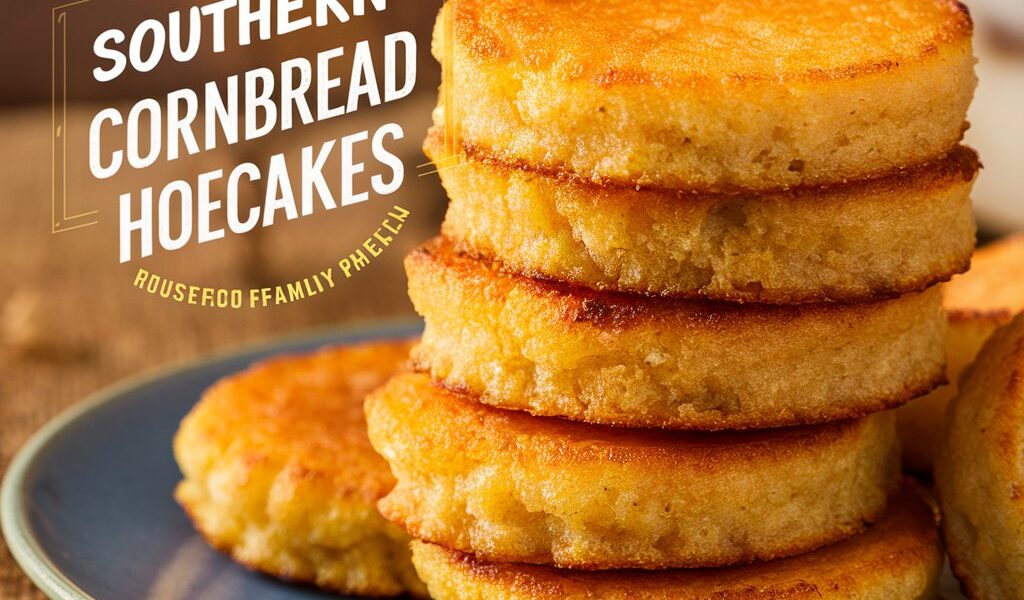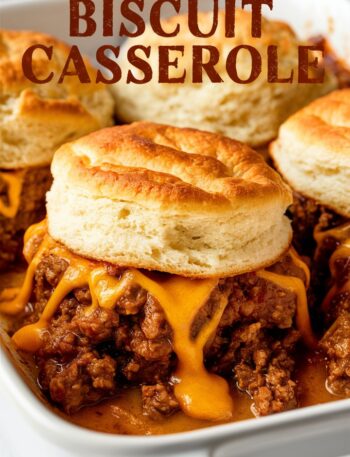Southern cornmeal hoecakes are one of those recipes that beautifully represent the soul of Southern cooking. Crisp on the outside, tender on the inside, and packed with rustic flavor, these skillet-fried cornmeal cakes are more than just food—they are a story of resilience, tradition, and hospitality passed down through generations.
Unlike cornbread, which is baked in the oven, hoecakes are cooked on a skillet, creating golden edges and a pancake-like shape. They can be enjoyed as a savory side dish, topped with syrup or honey for breakfast, or even used as a base for creative dishes. In this article, we’ll explore their history, variations, expert cooking tips, and of course, provide you with the ultimate recipe that will help you make authentic Southern cornmeal hoecakes at home.
A Brief History of Southern Cornmeal Hoecakes
The history of hoecakes stretches back hundreds of years, deeply intertwined with Native American traditions, African American heritage, and the agricultural history of the Southern United States.
- Native American Influence: Corn was a staple crop in Native American communities, and ground cornmeal was used to create early versions of flatbreads cooked over open flames. These simple cornmeal cakes inspired many variations across early America.
- African American Contributions: Enslaved Africans and African Americans played a vital role in the evolution of hoecakes. With limited resources, they created hearty, filling meals from cornmeal and water, sometimes cooked on the back of a hoe blade placed over hot coals—hence the name “hoecake.”
- Southern Tradition: Over time, hoecakes became a cherished part of Southern cuisine. As kitchens evolved, ingredients like buttermilk, eggs, and bacon grease were added, transforming hoecakes from survival food into a beloved comfort dish found at family tables, church gatherings, and holiday meals.
Today, hoecakes are celebrated as both a cultural icon and a versatile recipe that bridges the gap between history and modern Southern cooking.
Hoecakes vs. Cornbread vs. Johnnycakes
It’s easy to confuse hoecakes with similar dishes, but each has distinct characteristics:
- Hoecakes – Thin, fried on a skillet, with crispy edges and soft centers. Often made with cornmeal, flour, buttermilk, egg, and fat (butter or bacon grease).
- Cornbread – Baked in an oven, usually thicker and more cake-like, often served in wedges.
- Johnnycakes – Originating in New England, these are denser and typically made with just cornmeal and water, without flour or leavening.
Hoecakes stand out because of their balance between crispy texture and tender bite, making them a favorite for both savory and sweet pairings.
Ingredients and Their Roles
The secret to perfect hoecakes lies in simple, high-quality ingredients. Each one plays a role in creating the right flavor and texture:
- Cornmeal – The base ingredient, providing rustic flavor and crunchy edges. Stone-ground cornmeal delivers more texture, while finely ground cornmeal makes smoother cakes.
- All-Purpose Flour – Softens the texture, balancing the grit of cornmeal. Can be replaced with gluten-free flour for dietary needs.
- Baking Powder – Adds lightness, preventing the hoecakes from being too dense.
- Salt – Enhances flavor and balances sweetness if syrup or honey is used as a topping.
- Buttermilk – Contributes tanginess and moisture, resulting in tender hoecakes. (Substitute: milk + lemon juice or vinegar).
- Egg – Acts as a binder, giving structure and slight fluffiness. For vegan hoecakes, flaxseed or chia seed gel can be used.
- Butter or Bacon Grease – Provides richness. Bacon grease adds a smoky, savory depth that’s traditional in many Southern kitchens.
- Water – Adjusts the consistency of the batter.
- Vegetable Oil for Frying – Ensures crispiness. Oils with high smoke points like canola, peanut, or vegetable oil are ideal.
Step-by-Step Recipe for Southern Cornmeal Hoecakes
Here’s the detailed process to achieve golden, crispy, and authentic hoecakes:
Step 1: Mix the Dry Ingredients
In a large bowl, combine 1 cup cornmeal, ½ cup flour, 1 teaspoon baking powder, and ½ teaspoon salt. Whisk well to evenly distribute the leavening.
Step 2: Whisk the Wet Ingredients
In another bowl, whisk together 1 cup buttermilk, 1 egg, and 2 tablespoons melted butter or bacon grease.
Step 3: Combine and Adjust
Slowly mix the wet ingredients into the dry, stirring just until combined. Avoid overmixing to prevent tough hoecakes. Adjust consistency with a splash of water if the batter feels too thick.
Step 4: Heat the Skillet
Preheat a cast-iron skillet or heavy pan over medium heat. Add just enough oil to coat the bottom. The oil should be hot but not smoking (around 350°F).
Step 5: Fry the Hoecakes
Spoon 2–3 tablespoons of batter into the skillet for each hoecake, spreading slightly into a small pancake shape. Cook 2–3 minutes until bubbles form and edges set, then flip and cook another 1–2 minutes until golden brown.
Step 6: Drain and Serve
Place cooked hoecakes on paper towels to drain excess oil. Serve warm with butter, honey, syrup, or alongside savory dishes.
Printable Recipe Card
Southern Cornmeal Hoecakes Recipe
- Prep Time: 10 minutes
- Cook Time: 15 minutes
- Total Time: 25 minutes
- Servings: 8 hoecakes
Ingredients:
- 1 cup stone-ground cornmeal
- ½ cup all-purpose flour
- 1 teaspoon baking powder
- ½ teaspoon salt
- 1 cup buttermilk
- 1 large egg
- 2 tablespoons melted butter or bacon grease
- ¼ cup water (as needed)
- Oil for frying
Instructions:
- Mix cornmeal, flour, baking powder, and salt in a large bowl.
- In a separate bowl, whisk buttermilk, egg, and butter.
- Combine wet and dry ingredients; adjust with water for a pourable consistency.
- Heat skillet with oil over medium heat.
- Fry spoonfuls of batter until edges set; flip and cook until golden brown.
- Drain on paper towels and serve warm.
Expert Tips for Perfect Hoecakes
- Use cast iron for the crispiest edges.
- Test oil temperature by dropping in a small bit of batter—if it sizzles, it’s ready.
- Don’t flip too soon—wait for bubbles and set edges.
- For extra flavor, replace part of the water with cream-style corn.
- To keep hoecakes warm, place them in a 200°F oven until serving.
Variations and Regional Twists
- Savory Hoecakes – Add chopped jalapeños, shredded cheddar, green onions, or crispy bacon bits.
- Sweet Hoecakes – Mix in sugar, cinnamon, or vanilla; serve with maple syrup or fruit preserves.
- Appalachian Style – Sweetened with sorghum syrup or molasses.
- Cajun Style – Spiced with Cajun seasoning and sometimes topped with shrimp étouffée.
- New England Johnnycakes – A denser, flour-free variation.
Best Ways to Serve Hoecakes
- Breakfast – With butter, syrup, or honey, like pancakes.
- Side Dish – With fried chicken, collard greens, stews, or gumbo.
- Base for Meals – Used as buns for sliders, or topped with pulled pork or fried fish.
- Dessert – Drizzled with molasses or topped with fresh fruit and whipped cream.
Nutritional Information (Per Hoecake, Approximate)
- Calories: 150
- Carbohydrates: 20g
- Protein: 3g
- Fat: 7g
- Fiber: 2g
- Sodium: 180mg
Common Mistakes and Fixes
- Too Thick Batter → Add more water or buttermilk.
- Falling Apart → Batter needs more egg or flour.
- Greasy Hoecakes → Oil wasn’t hot enough.
- Burning Quickly → Heat too high; lower to medium.
- Bland Flavor → Add a pinch more salt, or try bacon grease instead of butter.
Storage and Reheating
- Refrigerate: Store in an airtight container up to 3 days.
- Freeze: Layer between parchment paper and freeze up to 2 months.
- Reheat: Warm in a dry skillet or 350°F oven. Avoid microwaving to prevent rubbery texture.
Health Benefits and Dietary Adaptations
- Gluten-Free: Replace flour with rice flour or gluten-free blend.
- Vegan: Use flaxseed egg and plant-based milk.
- High-Fiber: Choose whole-grain cornmeal.
- Lower Fat: Use olive oil instead of bacon grease.
Frequently Asked Questions (FAQs)
1. What’s the difference between hoecakes and cornbread?
Hoecakes are skillet-fried and thinner, while cornbread is baked and thicker.
2. Can I make hoecakes without buttermilk?
Yes, mix 1 tablespoon vinegar or lemon juice with 1 cup milk as a substitute.
3. Are hoecakes the same as pancakes?
No, pancakes are made with wheat flour and sugar, while hoecakes use cornmeal and have a rustic texture.
4. Can hoecakes be frozen?
Yes, freeze between parchment sheets for up to 2 months. Reheat in the oven.
5. Do hoecakes always need flour?
Not necessarily. Traditional recipes used only cornmeal and water, but flour makes them lighter.
6. Can I bake hoecakes instead of frying?
They’re traditionally fried, but you can bake them in a greased muffin tin at 375°F for 15–20 minutes.
7. What toppings go best with hoecakes?
Butter, honey, maple syrup, fruit preserves, molasses, or savory options like cheese and bacon.
8. Why are they called “hoecakes”?
Historically, they were cooked on the flat side of a hoe over an open fire.
9. Can I make hoecakes without eggs?
Yes, substitute with flaxseed or chia egg.
10. Are hoecakes considered healthy?
In moderation, yes—they’re high in fiber from cornmeal, but frying adds calories.
Conclusion
Southern cornmeal hoecakes are more than just a recipe—they’re a cultural treasure that reflects the ingenuity and tradition of Southern kitchens. With a crisp exterior, tender inside, and the versatility to be sweet or savory, hoecakes remain a timeless dish that can bring comfort to any table.
Whether you enjoy them with honey for breakfast, alongside fried chicken for dinner, or topped with molasses for dessert, these skillet-fried cornmeal cakes will always remind you of the heart and soul of Southern cooking.





